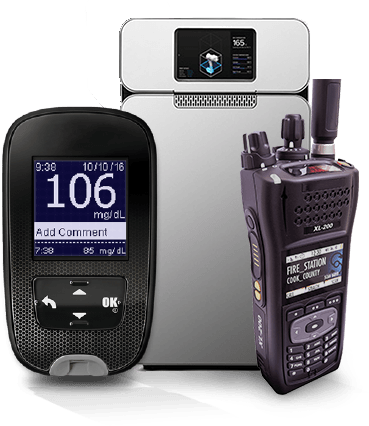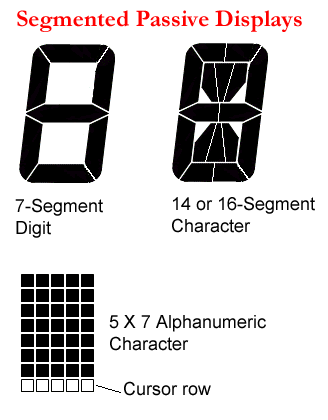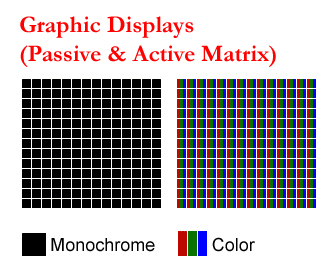
Technologies

Passive Monochrome LCD
Mono LCD (Monochrome Liquid Crystal Display) refers to the passive matrix, non-emissive display. Non-emissive LCD relies on the light from its backlight unit, and/or the surrounding to be visible. Passive-matrix LCDs used transistors to activate rows and columns, instead of sub-pixels. Most passive LCDs are monochrome, with the potentials to display colors through color diffusers.
Passive Matrix Monochrome LCD vs Active Matrix TFT Color Display
Strengths
Weaknesses
- Much lower cost
- Simple, energy-efficient driving
- Easy to customize the shape
- Slower response time
- Limited resolution, contrast, and viewing angle
- Can only display a few colors (see IBN)
- Not true black/white background
Our Strategies
- Compensation films to improve the background color (usually green-yellowish)
- Intelligent films to stabilize the performance over temperature changes
- Dummy cells to compensate for the retardation
BOE Technology Highlights
- IBN (Improved Black Nematic) display with super high contrast and color capability
Types and Market Trends
| Criteria | Type | Market demand |
|---|---|---|
| By Transmission Mode | Transmissive | -- |
| Transflective | Niche | |
| Reflective | Increasing | |
| By Switching Mode | TN | -- |
| STN | Increasing | |
| IBN | Increasing | |
| By Display Content | Character | -- |
| Segment | Increasing | |
| Matrix | -- |
How LCD works
As in its name, Liquid crystal displays utilize Liquid Crystals, which exhibit both characteristics of solid and liquid. Applying an electric field can change LC molecular alignment temporarily, and thus modulate the polarization of light passing through. LCDs don’t emit light themselves so they need other light sources.
The optical configuration of an LCD, often referred to as a “sandwich” structure, typically includes a) a front polarizer or analyzer; b) a back polarizer, cross-positioned to the front one in terms of polarization; and c) a liquid crystal layer in between.
Depending on transmission modes of the “light modulator”, LCDs can be divided into three categories: transmissive, reflective, and transflective mode, as illustrated below. Note that back polarizers in these LCDs are transmissive, reflective, transflective types accordingly, while front polarizers are always transmissive to let modulated light through.

Schematic diagram of the (a) Transmissive mode, (b) Reflective mode, and (c) Transflective mode
Reflective LCDs utilize ambient light from a front source, usually the environmental light. Whereas transmissive displays rely on LED backlights to illuminate the surface. Featuring a combination of both reflective and transmissive characteristics, a transflective LCD can take advantage of both environmental ambient light and LED backlight at the same time.
All three transmission modes are used in the passive LCDs, whereas most TFT LCDs are transmissive types.
Learn more about viewing modes and applicable lighting conditions.
1Tan, M. T., Richey, R., & Layton, J. LCD Fundamentals and the LCD Driver Module of 8-Bit PIC Microcontrollers. 2018. Microchip Technology. Retrieved from http://ww1.microchip.com/downloads/en/AppNotes/AN658-LCD-Fundamentals-and-the-LCD-Driver-Module-of-8-Bit-PIC-MCUs-00000658C.pdf
How Passive LCD works
Passive Matrix Liquid Crystal Displays use thin-film transistors to control the voltage applied to the liquid crystal layer. Unlike active-matrix TFT LCDs, transistors in passive-matrix LCDs are used to activate rows and columns, instead of each sub-pixel.
During each frame, the display matrix is addressed row by row. And display IC controls the intersection of each column and row. At intersections being activated, two electrode layers will apply an electric field on the liquid crystals in between, enabling those liquid crystals to twist and realign.
There are two ways to display distinguishable contents:
- Positive mode: display dark image on a light background (light blocked when voltage applied)
- Negative mode: display light image on a dark background (light passes when voltage applied)
Depending on how liquid crystals align under/without applied voltage, major LCD panel types by switching mode include:
- Positive/negative mode:
- (1) Twisted Nematic (TN) mode
- (2) Super Twisted Nematic (STN) mode and variations (e.g. FSTN, DSTN, ESTN, ISTN)
- Wide viewing negative mode:
- (3) Vertical Alignment (VA) mode – our IBN (Improved Black Nematic) mode
In Twisted Nematic (TN) mode, liquid crystals are parallel to the horizontal glass surface. Without applied voltage, they will twist 90° between perpendicularly placed front and rear polarizers to align with both orientations. They changed the polarization of light to let it pass through. Otherwise under applied voltage, the twist is eliminated. And the light that can pass the rear polarizer would be blocked by the front one. While TN LCD provides a simple, low cost, low voltage solution, it’s also limited by narrow viewing angles and a low contrast ratio.
TN mode is also used in color TFT LCDs. Learn more about TN TFT LCD.
In comparison, for Super Twisted Nematic (STN) mode and its upgrades, liquid crystals would twist 240~270 ° instead in a voltage-on stage. This “super twist” helps achieve a moderate improvement in viewing angles and contrast ratios.
To upgrade the performance to another level with ultrawide viewing and high contrast capability, check out our exclusive IBN technology using Vertical Alignment (VA) mode.
IBN (VA) LCD

Schematic diagram of the (a) IBN (VA) mode and (b) TN mode
IBN (Improved Black Nematic) display adopts the vertical alignment switching mode commonly used in TFT displays, and applies it to passive driven LCDs.
As illustrated in the schematic diagram, the front and rear polarizers are cross-placed to each other in VA mode. In the voltage-off stage, liquid crystals are perpendicular to the glass surface, thus lending no help to change the polarization of light. Polarized light is blocked by the front polarizer with a different polarization, presenting a clean, black surface with little light leakage. When a high voltage is applied, liquid crystals twist to align in parallel with the surface, and guide polarization changes for the light passing through.
With little “bleed-through” and high transmission, our IBN technology is able to achieve a very high contrast ratio (>1000:1) in a negative mode.
Moreover, our IBN technology goes far beyond a simple, monochrome LCD display – we provide total solutions of color IBN and Hybrid IBN+TFT display!

BOE Varitronix Color IBN

BOE Varitronix Hybrid Color IBN (entire top) + TFT (center)
Color IBN utilizes a color diffuser layer with designated areas painted in colors. For applications where there is a pre-designed layout with colorful icons or segment, color IBN provides a crystal-clear image, super high contrast, and vivid colors – all at a “passive-LCD-level” cost and energy consumption.
When “inexpensive” and “partial dynamic content” appear on your LCD requirement list at the same time, Hybrid IBN+TFT display is here to save the day. Our hybrid solution combines a complete, free-shape IBN at the top, with a small sized, standard TFT at the bottom. Overall, it looks like one display with free content to display within the TFT area and on/off color segments for the rest of the screen. The hybrid solution provides a cost-effective way to achieve the features and performance you need.
STN LCD

Schematic diagram of the (a) DSTN LCD, (b) ISTN LCD, and (c) FSTN LCD.
Depending on enhancement methods and structures, the STN LCD family has a wide range of variations for different needs, such as “silver mode” and “blue mode” for background colors, FSTN with a compensation film, and DSTN with a dummy cell for anti-retardation over temperature changes.
To compliment with STN LCD and types beyond, we also offer ESTN (Enhanced performance STN) and ISTN (Intelligent STN) at BOE Varitronix. Their structures are shown in the image.
ESTN (Enhanced performance STN) is a low-cost alternative for DSTN or FSTN. ESTN is used in negative mode displays and can be optimized via the backlight color to increase higher contrast. They usually have a blue background. However, they are not suitable for a high-temperature environment.
ISTN (Intelligent STN) has a special temperature-compensating liquid crystal polymer (LCP) film to enable a good performance under temperature fluctuations. It’s commonly used in the automotive industry and can work for more than 15 years.
You may find those variations of STN LCDs quite confusing but worry not – we have summarized their features for you in this comparison table:
Types of STN Passive Matrix LCDs
| Type | FSTN | ISTN | DSTN | ESTN |
|---|---|---|---|---|
| Name | Film compensated STN | Intelligent STN | Double STN | Enhanced performance STN |
| Cost | Lowest cost | Medium-high | Medium | Low cost |
| Structure | Has a retardation film | Has a special LCP film | has a dummy cell | Alternative to DSTN |
| Feature | Compensate for the common yellow-greenish background | Very good performance under temp. fluctuations | Resilient to the retardation over temp. changes | Increase negative mode contrast Blue background |
| Application | Industrial Normal environment | Automotive Industrial | Automotive With Heater | Industrial Not too high temperature |
Type of Monochrome Displays by Application
Passive monochrome displays are widely used thanks to their simplicity – simple to design, manufacture, and read. Depending on display content and applications, passive monochrome display can present content in formats including:
- Segment (7-segment digit numbers and icons)
- Character (14 or 16-segment characters)
- Matrix (Pixel images and wave forms)
With the type of content to display in mind, you can refer to the table below on what capabilities of LCD to look for.


LCD Types and Supported Display Content
| Content Type | Passive segment | Passive character | Passive matrix | Passive color IBN | Active-matrix (TFT) |
|---|---|---|---|---|---|
| Number | |||||
| ICON | |||||
| Character | |||||
| Pixel image | |||||
| Detailed image | |||||
| Several Colors | |||||
| 65K+ colors |
Segment displays are widely used for status display applications, such as clock/timer, motor speed and other gauges. And character displays enable the flexibility to display different text contents.
When it comes to system controllers, which require more complex settings, character displays would be more suitable for a variety of layouts, menus, and images.
From another aspect, Color IBN and TFT LCD complement each other well when there is more than one color to display. Color IBN lit up certain areas of the display under control as discussed in the previous section Color IBN. Otherwise if detailed, colorful contents, and a quick response are critical to your application, you are more than welcome to check out our introduction on TFT LCD and OLED display.
Editor: Charis Chen

